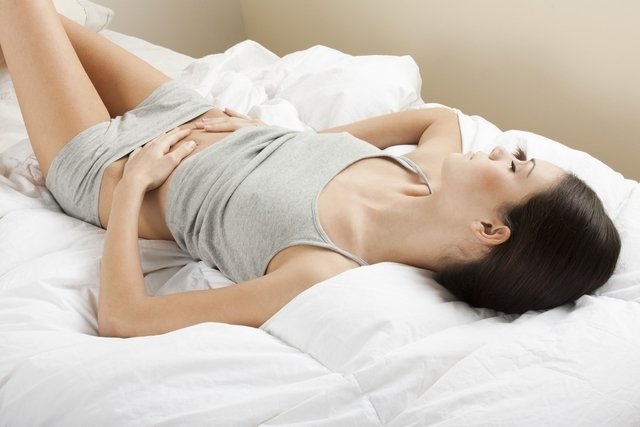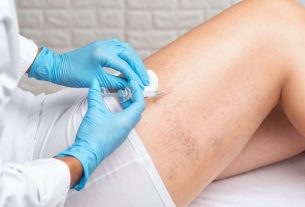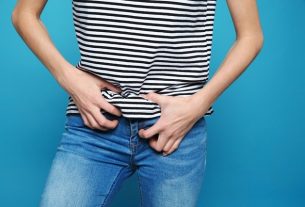The main symptoms of PMS are abdominal pain and bloating, increased appetite, back pain, difficulty concentrating, greater fluid retention, increased breast sensitivity, acne and headache, which may vary from woman to woman and may be more or less less intense.
PMS symptoms usually appear 5 to 10 days before menstruation and remain more intense until menstruation begins, and there may be more than one symptom at the same time.
PMS symptoms occur due to the common hormonal variation during this period, and it is important that a gynecologist is consulted when symptoms are very intense and interfere with daily activities.

Main symptoms
The most common symptoms of PMS are:
- Abdominal pain and swelling;
- Pain or tenderness in the breasts;
- Nausea and vomiting;
- Dizziness and fainting;
- Constipation or diarrhea;
- Acne;
- Headache or migraine;
- Intense desire for sweet foods;
- Insomnia or excessive sleep;
- Greater emotional sensitivity;
- Difficulty concentrating;
- Irritability or nervousness;
- Tension and anxiety;
- Weight gain due to fluid retention;
- Back pain, especially in the lower back.
Although they can be quite uncomfortable, PMS symptoms can be alleviated through regular physical activity and a healthy, balanced diet. See the main ways to alleviate PMS symptoms.
Make an appointment with your nearest gynecologist to evaluate your symptoms in more detail:
Taking care of your health has never been easier!
Severe PMS symptoms
The intensity of PMS symptoms varies from woman to woman and can be considered mild or strong. In the most intense cases, PMS symptoms can be disabling and affect daily activities, causing women to lose interest in daily activities, miss work, make decisions based on personal feelings or be aggressive towards people close to them.
In these cases, it is important to consult a gynecologist to begin the most appropriate treatment, as it may be a disorder called premenstrual dysphoric disorder, which can even lead to the emergence of anxiety attacks or the development of depression. Understand better what premenstrual dysphoric disorder is and how it is treated.
PMS online test
If you think you suffer from PMS, please answer the following questions to find out your chances:
The symptom test is only a guidance tool and does not serve as a diagnosis or replace a consultation with a gynecologist.
Why do symptoms arise?
PMS symptoms arise due to a gradual drop in estrogen production and an increase in progesterone production, around the 14th day of the cycle, which also influences the amount of serotonin in the brain, a hormone responsible for controlling mood and sensation. of well-being.
Around the 26th day of the cycle, the production of estrogen and progesterone hormones is practically zero, which causes menstruation to occur, and around 3 to 4 days after the start of menstruation, the levels of these hormones begin to increase and PMS symptoms disappear.
How to relieve PMS symptoms
PMS symptoms can be alleviated (or controlled) with some simple measures, such as:
- Practice regular physical activity, such as walking, swimming or cycling, as they help to release serotonin and endorphins in the body, which increase the feeling of well-being, relieving symptoms of anxiety, nervousness and irritability. Furthermore, exercise helps to reduce tiredness, combat insomnia, excess sleep and difficulty concentrating and improve the functioning of the intestine and blood circulation, combating constipation and bloating;
- Increase fluid consumptiondrinking at least 8 glasses of water a day, as it helps reduce abdominal bloating and constipation, and also keeps the body hydrated in case of diarrhea;
- Increase consumption of foods rich in fibersuch as fruits, vegetables, grains and cereals, for example, to help relieve constipation and increase satiety, which reduces the desire to eat sweet foods;
- Consume foods rich in tryptophansuch as banana, cheese or cashew nuts, as they help to increase the production of serotonin, a neurotransmitter responsible for improving mood and increasing a sense of well-being, which improves symptoms of bad mood, feelings of hunger and excessive sleep.
Furthermore, to reduce PMS symptoms it is important to avoid consuming foods or drinks rich in caffeine, salt and alcohol, as they increase abdominal swelling and fluid retention. See other foods that should be avoided during PMS.
Watch the following video with other tips on how to alleviate PMS symptoms:
Bibliography
- HOFMEISTER, S.; et al. Premenstrual Syndrome and Premenstrual Dysphoric Disorder. Am Fam Physician. 94. 3; 236-40, 2016
- APPLETON, S. M. Premenstrual Syndrome: Evidence-based Evaluation and Treatment. Clin Obstet Gynecol. 61. 1; 52-61, 2018
- RYU, A.; KIM, T. H. Premenstrual syndrome: A mini review. Maturity. 82. 4; 436-40, 2015

Sign up for our newsletter and stay up to date with exclusive news
that can transform your routine!
Warning: Undefined array key "title" in /home/storelat/public_html/wp-content/plugins/link-whisper-premium/templates/frontend/related-posts.php on line 12
Warning: Undefined array key "title_tag" in /home/storelat/public_html/wp-content/plugins/link-whisper-premium/templates/frontend/related-posts.php on line 13




